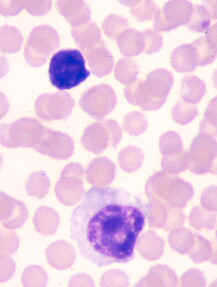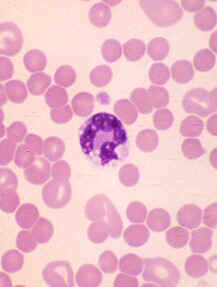
Wright's stain, 1000x

Wright's stain, 500x
Monocytes
The monocyte on the left (lower leukocyte) contains a moderate amount of cytoplasm and some cytoplasmic vacuoles. Its cytoplasm is slightly more basophilic than that of non-toxic neutrophils. Monocytes can have a variety of nuclear shapes. Their nucleus can be round, clover-shaped, or lacy; it can resemble a lymphocyte's small, round or slightly indented nucleus, or a granulocyte's segmented nuclear appearance. Monocytes are generally larger than lymphocytes and neutrophils (compare the monocyte at the bottom of the left hand microphotograph with the lymphocyte seen near the top of the image). In light of the monocyte's ability to imitate its lymphocyte and neutrophil neighbours, a useful characteristic that allows them to be distinguished from other cells and specifically from neutrophils is their looser (less dense) chromatin content. This requires one to compare the cells while examining a blood smear.
 Wright's stain, 1000x |
Wright's stain, 500x |